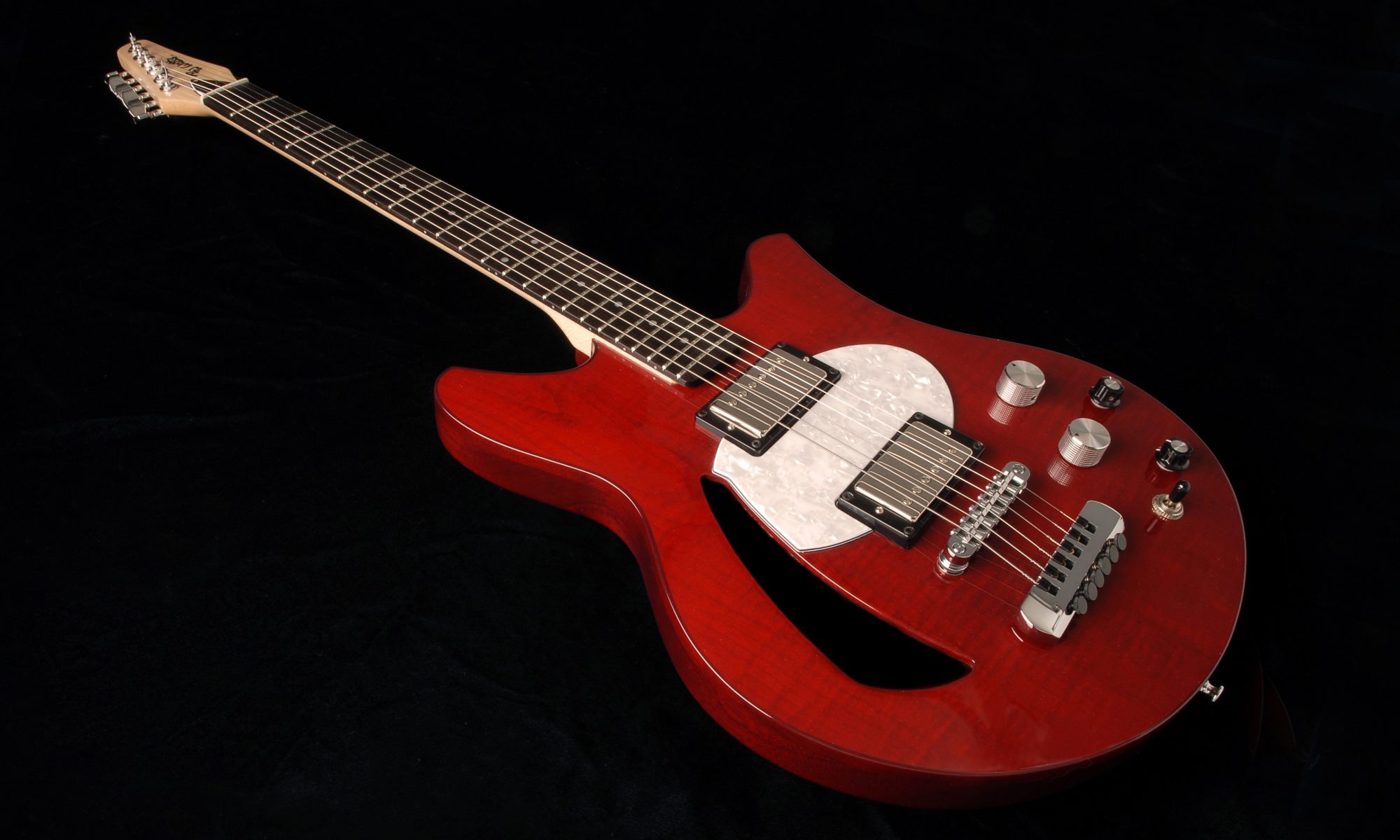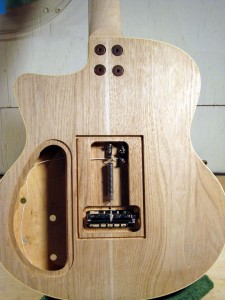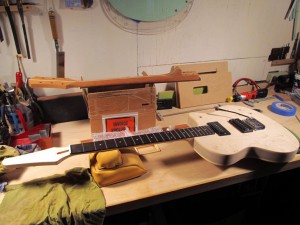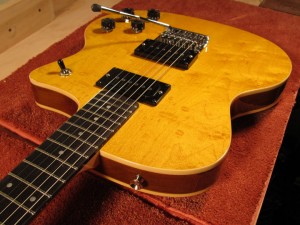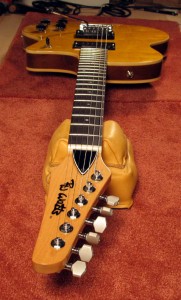The PROBLEM SO FAR – or – why you need to think everything
through – or – how a seemingly simple change has cascading effects.
The back story:
whammy bars. In the 1950’s, Leo Fender and Co. in a fit of inspiration/madness
started adding ‘tremolo bar/tailpieces’ to their Stratocaster model electric
guitar as standard issue. There is generally some confusion about the
difference between ‘tremolo’ and ‘vibrato’, not least because the two words
have often been used interchangeably, and sometimes a tremolo tailpiece has
been referred to by the manufacturer as a vibrato tailpiece, but the effect has
been used throughout rock & roll music almost since its inception. The
effect, by hitting/depressing the tremolo (whammy) bar produces a wavering
sound much like vibrato in a singer’s voice. It is an ’emphasis’ effect (just
as a piano has ’emphasis’ pedals). Technically, though, vibrato differs from
tremolo (in guitar playing lexicon) as the former is more like hitting an
on/off switch, where the pitch remains constant but with distinct separation
between volume peaks – more of an ah-ah-ah-ah-ah sound, whereas the latter
achieves its wavering effect by variation in pitch – think of the sound running
up and down a roller coaster track. The tremolo/whammy bar achieves this effect
by de-tensioning/re-tensioning the guitar strings at the bridge. As the whammy
bar is attached directly to the bridge, by pressing down on the bar, the bridge
pivots forward on a fulcrum point, slackening the strings and thus lowering the
pitch, and releasing the whammy bar (or pulling up on it) allows the powerful
springs that attach the unit to the guitar body to snap the strings back to
full tension and thus back to true pitch – in theory.
Vibrato can be achieved by the fretting hand of the guitar
player by a kind of ‘waggling’ motion of the finger pressing on the string as
it is ‘fretted’, or, more commonly for electric guitar players, through a
vibrato effect built into the guitar amplifier – an effect that Fender supplied
(and still does) on many of its amps. Perhaps the clearest example of the use
of this vibrato/amp effect is to listen to almost any song played by Pops
Staples of the Staples Singers. It’s just Pops on electric guitar (a Stratocaster
into, probably, a Fender Princeton Reverb amp – or perhaps a Twin-Reverb amp)
and his singing family.
Tremolo can also
be achieved by the fretting hand of the guitar player by moving the depressed
string ‘across’ the fret board while playing, as this adds tension then
releases tension on the given string and thereby causes a change in pitch – or
– also on the electric guitar so equipped, by hitting the whammy bar. Clear
examples of use of the whammy bar are to be found all the way back in the 60’s
by almost everything from The Ventures, the Shadows on ‘Apache’ (they even did
a very credible version of Santo and Johnny’s ‘Sleepwalk’, originally done with
a (pedal) steel guitar, by judicious use of the tremolo bar), and even through
our current time by that wild man of the whammy bar, Jeff Beck. Some of my
all-time favorite whammy bar work (with added echo and reverb) is on Chris
Isaak’s version of ‘Wicked Game’. Obviously, the whammy bar has been important
to rock guitar sound over the decades, but I’ve resisted putting them on my
electric guitars. Why? Because, in general, they’re unreliable pieces of crap!
More in Part 2.
Part 2: The
PROBLEM SO FAR – or – cascading negative effects unleashed.
All right. So,
whammy bars – love them and hate them.
Tremolo/whammy
bars work by slackening/de-tuning and then re-tensioning/re-tuning the guitar
strings to create that wavering sound effect. In theory, everything should work
just fine, but they don’t, primarily for one of two reasons that I call either
weak bridge/strong springs or strong bridge/weak springs.
For whatever
reason, Fender never really put that much effort into fine-tuning its tremolo
bar/bridge set up. They have the weak bridge/strong springs get up. They
provide a fulcrum point for the whammy bar by anchoring the top/front edge of
their bridge to the guitar with two somewhat loosened screws and allow for the
strong springs on the underside of the guitar (recessed into a cavity) to keep
the bridge pulled down tight to the body of the guitar. The more aggressively
the whammy bar is used, the looser the screws holding the bridge in position
become and the less the springs can be relied on to return the strings to
pitch. On top of that, no one took into account that as the string tension is
loosened through whammy use, the tautness of the strings at the tuning peg end
of the guitar (at the headstock end) slips and when tension returns, the string
tends to return to an out of pitch spot. Upshot: for anything other than mild
whammy bar deployment, you’re constantly retuning the guitar. As often as not,
one or more strings is out of pitch to the other strings most of the time. Not
necessarily by much, but enough to be annoying to people like me. Jeff Beck
doesn’t care because he doesn’t really care about ‘being in tune’ to begin
with.
Gibson, as the
other major historical manufacturer of electric guitars didn’t deal effectively
with the tremolo bar issue either. They made a tinny, piece of crap one based
on Fender’s set-up that they deployed on some of their electrics, but on their
flagship guitar, the Les Paul model, they pretty much avoided the whole issue
by not offering one. If one was added, it was usually the granddaddy of
aftermarket whammy bars, the Bigsby Vibrato (there’s that vibrato/tremolo
confusion again) – developed sometime in the 1950’s I think. The Bigsby Vibrato
is what I would call the strong bridge/weak springs version of the whammy bar.
They had a very solid and sturdy connection of the bridge to the guitar body,
but they relied on a self-returning spring mechanism (much like you’d find in
self-closing hinges mounted to swinging doors like you’d see in a restaurant
coming out of the kitchen) that was not really strong enough, in my estimation,
to reliably do the task at hand. Changing string gauges could mess things up,
and you still had the same problem at the tuning peg end of the guitar of
losing string tautness. So neither system really worked without spending a lot
of time as a player re-tuning.
Things changed,
however, when in the 80’s there was a great flurry of innovation from
after-market manufacturers. People like Floyd Rose developed a ‘locking
tremolo’ that dealt with the de-tensioning/re-tensioning issue at both ends of
the guitar. With a better bridge movement mechanism and (key) a locking nut
that clamped the strings into immobility at the headstock end to eliminate the
string slippage that happened before. With the uncontrollable slackness issue
dealt with by keeping each string limited to a very specific length and locked
down tight, the player could dive bomb with his whammy bar to his/her heart’s
content, and the strings would snap back to perfect pitch every time – in theory.
Players like Eddie Van Halen used the locking tremolo to great effect and he
became famous for his whammy bar ‘dive bombing’ effect where he would
de-tension his strings so completely they would lose all sound, then he would
pull the bar up and they sprang back to life. While the Floyd Rose tremolo, and
others like it were a definite improvement, they were difficult to adjust once
set. The process was so arduous, that unless things were severely out of tune,
you didn’t really want to mess with it. So – ultimately not the answer either,
which takes me to Part 3.
Part 3: The
PROBLEM SO FAR
Ok, so I haven’t
quite gotten to the problem yet, but I wanted to explain why I’ve avoided
putting tremolo/whammy bars on my electric guitars – you spend too much time re-tuning
the guitar instead of playing it. Problem is I really like what they do.
Several months ago I ran across a new
manufacturer of whammy bars/bridges call Trem-King, that promised that they had
solved much of the inherent problems with the standard tremolo mechanism (as
outlined in parts 1 & 2), I checked out their product, decided that I
should give it a try and see how well it works. No problem.
I’ve spent several years fine-tuning guitar
designs where I’ve largely worked out all the kinks for my desires, and I
thought I’d just adapt one these to allow for a tremolo bar addition – which is
what you see in the picture. I knew I would need to do some modification, so
after getting the new mechanism, I measured carefully and realized I’d have to
make the body of the guitar thicker by 1/8″ to accommodate parts of the
mechanism. I did that, and after careful marking, located the position for the
cut-outs necessary for housing the unit and routed those cavities. Easy-peasy.
I had a neck that I made from mahogany (seen in the background behind the
guitar) that I wanted to use (and it had a nut adjustment I wanted to try out).
The neck is made to be of the bolt on variety (although it could just as easily
work for a glued-in – ‘set neck’ – approach). I set it into the cavity that is
routed into the body for specifically that function. Got some longer bolts that
I needed to secure the neck to the body, attached the neck, and realized that
the fret board was higher than the bridge. This is of course a no-no, as the
strings actually have to travel very shallowly ‘uphill’ to the bridge, so the
bridge can’t sit below the height of the fret board. I thought, well, I could
shim under the bridge/tremolo to raise the whole mechanism to the proper height
needed. I needed about 1/4″ of added height, and I thought it’d look kind
of clunky with that tall a shim/spacer, but maybe it’d be ok.
Then I realized
that if I raised the trem/bridge mechanism that much, the tremolo wouldn’t
actually work correctly. Ok, well the trem was really designed to work when
attached directly to the guitar top – no shim/spacer, so that meant if the
bridge couldn’t go up, the neck/fret board had to go down. I could make that
happen – just rout the neck cavity deeper to make the neck drop down further in
the body. Then I realized that the ‘heel’ of the mahogany neck I had planned to
use (you see it sticking up vertically about 3/4 of the way down the neck)
would now stick out below the bottom of the guitar when in place. Yes, I could
trim down the heel, but I thought that’s kind of butchering the neck, so I
decided to use another neck (maple – that’s on the guitar) that’s of the more
traditional bolt-on variety. It’s recessed as far as I can go into the guitar
body, and now I had to go back to the shorter bolts to attach the neck. I might
just have gained enough room for the strings to clear effectively, though I may
have to still increase the overall height at the bridge a little. Now, though,
the pick-ups, which work fine in my normal set-up, stand up a little too tall
compared to where the strings will cross over them, so I will have to drop
those down into the body further in order to make them work, but if I do that
on the rear pick-up, I will be into the spring cavity that controls the tremolo
on the underneath side of the guitar. So now I have to consider whether to go
with a whole new set of pickups that attach differently in order to make things
work. It would have been easier, perhaps, to start from scratch with a whole
new design rather than trying to adapt one I had already “worked
out”. And one little ‘not completely thought through’ modification has
caused a cascading series of “fixes” that may yet prove to be
unworkable. We’ll see. It seems you can never spend too much time thoroughly thinking the seemingly simple things through.
